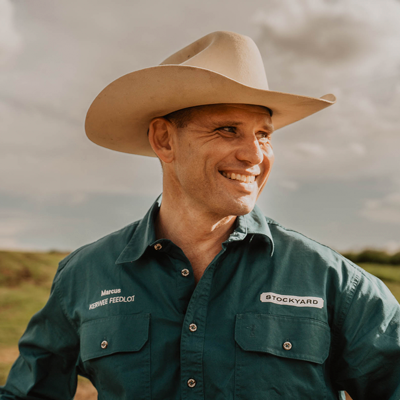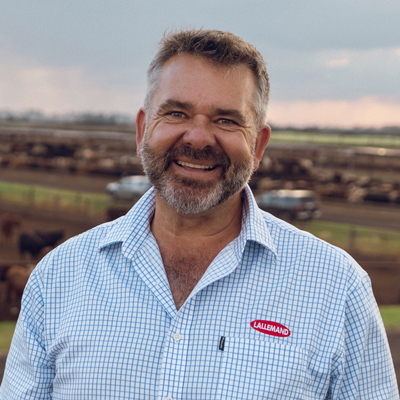Blog | Reading Time 7 minutes
Reducing BRD: Stockyard’s Successful Trial with ProTernative Yeast
A large-scale commercial trial involving more than 10,000 grainfed cattle has demonstrated the effectiveness of a live yeast in reducing the incidence and severity of bovine respiratory disease (BRD) and associated treatment costs.
The trial was conducted by Stockyard in partnership with Lallemand Animal Nutrition, a global leader in microbial technology, and supervised by the consulting veterinarian, Dr Matt George of Bovine Dynamics.
All Angus steers entering Kerwee Feedlot’s 200-day feeding program between June and December last year were fed a grain-based ration that contained ProTernative, a strain-specific live yeast (Saccharomyces cerevisiae boulardii CNCM I-1079).
The yeast is scientifically-proven to optimise gut health and boost immunity in ruminants.
It is also used extensively in human healthcare to restore native microflora populations after medical treatment.
Sourced from Stockyard’s established supply chain, the steers had an entry weight of 420-450 kg and an exit weight of 700-800 kg.
Pull rates, mortality, treatment and mortality figures were recorded and compared to the same six-month period the previous year.
This comparison showed an impressive 37% reduction in pull rates; a 32% reduction in BRD cases; a 20% reduction in the number of cattle receiving an antibiotic treatment; and a 14% reduction in all-cause mortalities.
Overall, BRD treatment costs were reduced by 44% compared to the same six-month period the previous year.
The results of the trial are consistent with other large-scale commercial trials conducted in USA, which have shown ProTernative significantly reduces sickness and mortality rates associated with BRD, as well as improving growth rates, feed efficiency and carcase quality.
Stockyard is a third-generation, family-owned business that breeds and finishes approximately 30,000 Wagyu and Angus steers for a range of premium and export markets each year.
Established by Robin and Del Hart almost 70 years ago, Stockyard is now operated by Lachie and Sarah Hart, with their daughters, Bec and Ali, also working full-time in the business as Marketing Manager and Innovation Manager, respectively.

Stockyard Chief Operations Officer – Pastoral & Livestock, Marcus Doumany, who has nearly 25 years’ experience in managing pastoral properties and feedlots, says BRD remains the single leading cause of sickness and death in feedlots.
“It’s an unfortunate fact that disease can occur when young cattle from different backgrounds move into an intensive feeding situation,” he says.
“BRD is not just an animal welfare issue, as it has an obvious impact on livestock performance.
“A sick animal is not going to perform to its potential and ultimately, that’s going to affect its carcase quality.
“No one in this industry wants to see an animal suffer.
“Prevention is always better than cure and we do everything we can to make sure our cattle adapt from a pasture background to an intensive feeding environment.”
Stockyard elected to trial ProTernative last year following discussions with their nutritional and veterinary consultant, Dr Matt George, and Lallemand Animal Nutrition Technical Services Managers, Nathan Lister and Matt Bekker.
“Ali and I then visited the US early last year, where we saw ProTernative was being used in about 80% of the feedlots we visited,” Marcus says.
“We took the plunge and agreed to trial ProTernative for a month and we saw some exciting outcomes from the outset.
“Initially, we didn’t tell our stock team about it so they didn’t have get any preconceptions about what might happen.
“After about four or five weeks, they were saying, ‘There’s something wrong, we don’t seem to be pulling or treating as many cattle as usual.’
“We decided to go for another two months and then continue out to six months so we had meaningful data to compare.”
Marcus says several environmental factors need to be considered when interpreting the results.
“We had twice the number of wet days and above-average rainfall during the last six months of 2024, which not only increased disease pressure but impacted our pre-conditioning program,” he says.
“We normally pre-condition our steers in a paddock environment for 28 days before they are inducted into the feedlot, but the wet weather meant some of these paddocks could not be used.
“On the other hand, the completion of a major pen floor upgrading program would have also contributed to the reductions in morbidity and mortality rates.”
Stockyard has since incorporated ProTernative into all of its Angus rations throughout the year.
“A hot summer, an early autumn, a wet winter – it doesn’t take much to come undone by BRD and we don’t want to risk the improvements we’ve made by taking it out,” Marcus says.
“Managing biology is a humbling experience – as fast as you can address one factor, the next challenge tends to reveal itself.
“There is no get-out-of-jail card for BRD – it requires relentless discipline.
“If we can get all the little ‘one percenters’ right, then ProTernative is going to play its role in helping to avoid a bad outcome in terms of animal welfare.”
Stockyard Innovation Manager, Ali Hart, who has worked in the family business since 2020, says the trial has been part of a multi-factorial program to improve BRD management at Kerwee over the past two years.
“There’s nothing ‘new’ about vaccines, pre-conditioning or probiotics but rather it’s the way they are implemented,” she says.
“We market five brands and one of our specifications is ‘natural’, which means the animal has never been treated with an antibiotic or HGP.
“ProTernative reduced our treatment rate from 36% to 16%, which meant that we had 2,000 or so more cattle eligible for that specification.
“That gives us more options – and more options means less risk.
Marcus and Ali both acknowledged the crucial role of their livestock team in safeguarding animal welfare.
“It’s not just about products or processes, it’s about people and I genuinely believe we have one of the best livestock teams in the industry,” Marcus says.
“Everyone wants to do the best by our cattle and they go the extra mile every day because they genuinely care about the outcomes.
“We are absolutely committed to minimising our use of antibiotics whilst maintaining the highest standard of animal welfare.
“There’s a subtle nuance in knowing which animals to pull and which animals to treat and our pen riders do an exceptional job in that regard.
“We don’t mass treat animals and we are proud of that.
“Our goal always is to get treated cattle cured and back to their pen as quickly as possible – and we’re pleased to say that about 80% of the cattle we treat for BRD go on to meet their intended market.”

Lallemand Technical Manager, Ruminants, Matt Bekker, believes ProTernative offers a number of important animal welfare, antibiotic stewardship and sustainability benefits for the Australian lotfeeding industry.
“ProTernative is technically a probiotic in that it lives symbiotically with its host,” he says.
“This unique live yeast enhances the gut environment for beneficial microorganisms, supporting the host’s native intestinal microbiome.
“However, it contributes two other important benefits in that it activates the immune system while reducing local and systemic inflammation, both of which can reduce the negative impact of stress in cattle.
“If used correctly, feeding cattle with an immunobiotic solution may provide an alternative to mass treatment with an antibiotic or having to pull-and-treat multiple sick cattle.
“New-generation antibiotics are few and far between, so current therapeutics must be used with greater precision to extend their effective life.”
Published Apr 3, 2025